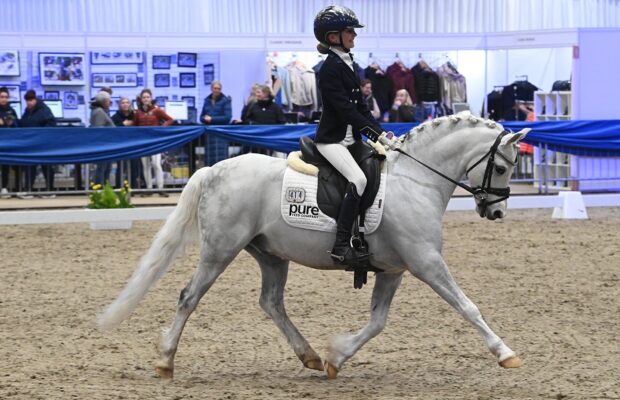At the British Dressage National Convention (25 November), Horse & Hound columnist Laura Tomlinson hosted a masterclass on how to prepare less experienced horses for competition and shared her top novice dressage training tips.
She was joined in the arena by her demo riders, Abbie Newbury on the then five-year-old Seagry Viceroy and Sophie Wallace on the then seven-year-old First Light. We’ve rounded up her top five tips below.
1. The basics matter
“Growing up, riding with my Dad and all through my career so far, I was never allowed to ride a flying change before my simple changes were good enough, or collect a horse until they were truly stepping forward into the hand – even on my grand prix horses I had to always keep the scales of training in mind,” says Laura.
“It’s so important with a horse of any level to keep the basics in mind, and if you spend a bit more time working on this stage of a horse’s training they’re going to give you a much nicer feel, if and when they go up through the levels.
“I like to catch the horse’s attention and make them think a little bit, so they’re having to focus on the rider and they’re less likely to get distracted,” says Laura.
In her session with Abbie, this involved riding a lot of transitions as well as giving and retaking the reins to allow the horse to find his own balance.
“We’re not asking for proper collection at this stage in their career, but balance is separate to collection,” Laura explains. “We can still have a horse nicely in balance with an uphill tendency without being in full collection.”
She was looking for Abbie to be pushing forward with her seat and leg, keeping a positive forward momentum through transitions, while encouraging the horse not to drop with his poll and fall onto the forehand.
“The better their balance at this stage and the more they build the strength to carry themselves, the easier the communication is going to be later on as they learn more movements.”
2. Use your seat, not your hands
Laura asked her demo riders to control the rhythm of their rising trot with their seat rather than their hand. She had both ride an exercise where they did a downwards transition from trot to walk using only their seat, no hands.
The nicer and more subtle the communication can be at this stage, Laura explains, the easier it will be to introduce new movements.
“If we can teach them to listen to our seat to slow down the rhythm rather than our hands, we can later teach the half-halt without pulling back and the frame shortening,” she says. “It’s something that’s worth spending a lot of time on at this stage in training.”
Likewise, she asked her riders to ride serpentines where they steered with their shoulders, not their hands. As they turned right they would bring their right shoulder back, turning their upper body towards the direction of travel, and the same on the left.
“The more our body and seat can do the less our hands have to do and the less we interfere with the horse’s mouth and movement in a negative way.”
3. Make it easy for the horses
With inexperienced horses there are always liable to be hiccups, says Laura.
“It’s important that they learn that they’re never going to be pushed above their limits and that you’re never going to ask something they can’t do.”
At the same time, she wants her riders to challenge their horses enough so that they build strength, coordination, suppleness and ability. But she wants them to do it using clear language.
“If a horse is struggling with something we have to find a new way to ask that question and make it simple for them,” she says. “Always positively reinforce the good work, but don’t reprimand the stuff we don’t want to feel – show them another way instead.”
With Abbie and Sophie, she interspersed a lot of walk breaks on the buckle, which she used as a tool to see whether the horse was relaxed over its back or holding a of tension.
4. Nailing the canter work
Before asking for any of the canter movements that come up in novice tests, Laura first wants to establish a good rhythm and connection: “So it feels like he’s taking your leg into the hand positively and politely.”
“It’s okay to carry a bit of momentum,” she says, “especially if they haven’t got enough strength to carry themselves in a collected canter yet.”
On canter-to-walk transitions, she asks both riders to give with their hands as they go into walk so that they don’t “trap” the hindlegs.
“Every time we have too much pressure in the hand we impact the hind legs,” she explains. “It’s the same as when we ask for canter, give with the inside hand to show that the inside hind leg can come through, this will help keep the transitions uphill.”
Often horses will have one rein where they find simple changes very easy, she adds, but it’s important to make sure everything is symmetrical so she recommends spending longer on the less-good side.
She introduces counter canter slowly, riding loops from the track to the centre line and then back.
“In counter canter, it’s important to sit in balance. On the right lead, keep your weight down the right stirrup, try not to shift too much to the left.”
5. Going from rising to sitting trot
“Something that we often don’t think about as riders is the difference for a horse that goes from being ridden in a long, young-horse frame in rising trot, to going up a level and having us sitting on their backs all the time – that takes time for a horse to get used to,” says Laura.
“We’ve all sat on horses that are super comfortable to sit to, but I’m sure we’ve also had horses that are hard to sit to. I think that is because when we first go sitting the horse gets tense in the back.”
When introducing sitting trot Laura does it incrementally. Here she asks Sophie to ride in a rising trot in a big circle around her, slowly adding in a few strides of sitting trot before returning to rising.
“You don’t want to just plonk yourself into sitting, but lower yourself steadily into it,” she explains. “Over the space of the circle build into the sitting trot, when you feel them start to struggle go rising again. Over time gradually build up the time spent in sitting. Remember, it doesn’t have to happen all at once.”
You may also be interested in…

‘Keep it fun and easy’: Charlotte Dujardin’s top 5 tips for developing young horses

Master advanced movements with top tips from Gareth Hughes and Richard Davison

Subscribe to Horse & Hound magazine today – and enjoy unlimited website access all year round
Horse & Hound magazine, out every Thursday, is packed with all the latest news and reports, as well as interviews, specials, nostalgia, vet and training advice. Find how you can enjoy the magazine delivered to your door every week, plus options to upgrade your subscription to access our online service that brings you breaking news and reports as well as other benefits.






